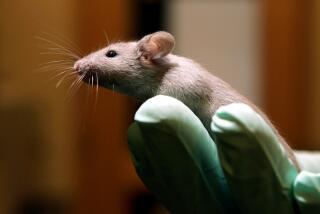Misidentification, contamination hamper cell-based research
Cell lines commonly used in medical research are plagued by contamination and misidentification, according to experts, and scientists need to do more to clean up their act.
âSince the 1960s, more than 400 widely used cell lines worldwide have been shown to have been misidentified,â wrote a group of prominent researchers in Thursdayâs issue of Science.
âCells originally thought to have been derived from one tissue type have later been found to be from a different tissue. In some cases, even the species of the cells has been misidentified.â
The article, written by Jon Lorsch, director of the National Institute of General Medical Sciences; Francis Collins, director of the National Institutes for Health; and Jennifer Lippincott-Schwartz, president of the American Society for Cell Biology, said the problem can affect many fields of research.
âIf a drug is tested on the wrong cell line, research can lead to unreliable results, and discovery of effective treatments can be delayed,â the authors wrote.
During lab work, cell lines can become contaminated by bacteria or viruses, or researchers can unwittingly mix different cells together. This might occur when a pipette is used more than once when working to different cell lines. If misplaced cells reproduce more quickly than the experimental cells, they can dominate the sample.
Although attempts have been made in the past to address the issue, the problem has persisted.
âThe time and cost required for authenticating cell lines likely has been a barrier to widespread adoption of best practices,â the researchers said. âShortcomings in training also play a role, as do sociological issues. For example, it is hard for both individual scientists and their fields to accept that their work could be called into question because the wrong cell line was used.â
The authors of the article have called for renewed focus on the issue and say that improved training and new technology aimed at authenticating cells are needed.
âFor its part, the NIH is considering several approaches to help catalyze improvements in identifying cell lines and maintaining their integrity,â they wrote. âFirst, grant applicants may be required to provide information on how they intend to address concerns about the identity of cell lines ... and contamination of their cells.â
The authors wrote also that scientific journals should require researchers to include data on cell line quality and identity.
Follow @montemorin for science news







